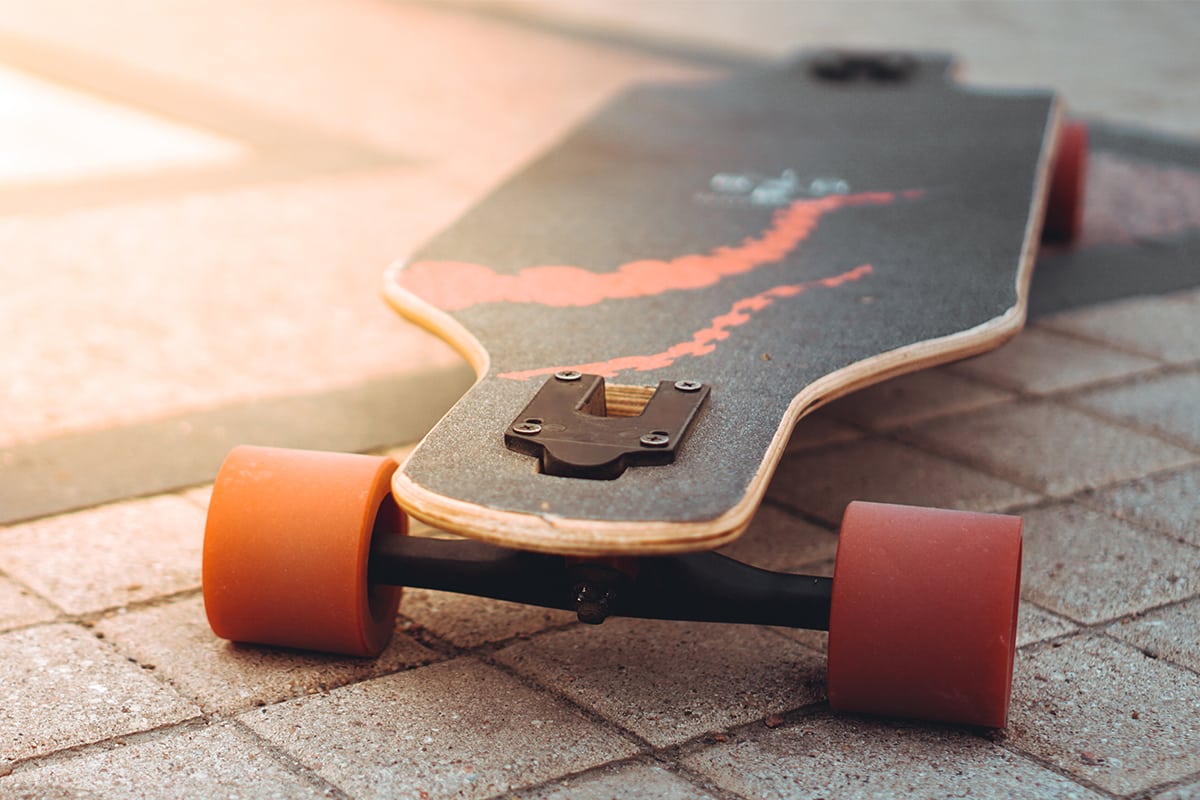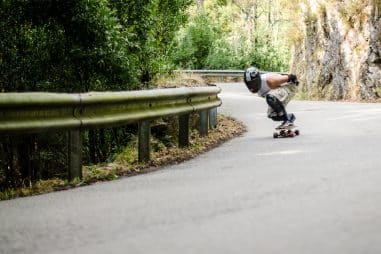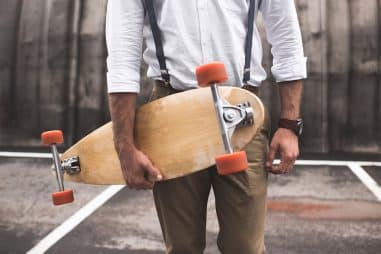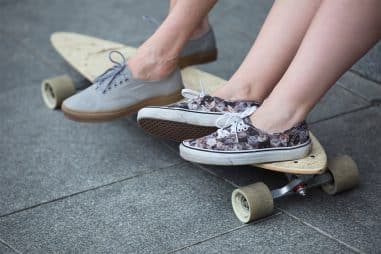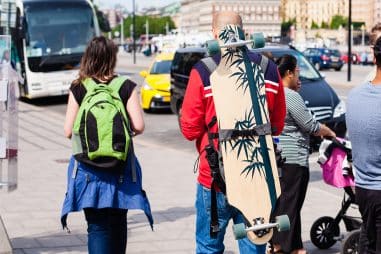The wheel diameter, wheel contact patch, and wheel hardness (durometer) are some of the variables that will greatly affect your longboarding. Having said that, it is important to know what you are going to use your board for before you pick out longboard wheels. There are many options to choose from so knowing what you want to use it for ahead of time will help you narrow down your list.
What Are the Best Wheels for a Longboard?
The best wheels for a longboard depend on what kind of riding you plan to do and where you plan to do it. Once you have figured out these two things, you must consider what wheel hardness (durometer) will fit your longboard best. Most of the time, softer wheels will be best for your longboard if you want to go cruising around while harder wheels will be best for your longboard if you would like to do some tricks.
There is a wide variety of longboard wheels to choose from and each type is made for different kinds of riding. As previously mentioned, you also have to account for the diameter and contact patch of the wheels aside from the hardness of the wheels. These three factors will have a huge effect on your board set up and your overall longboarding experience.
What Does 78a Mean on Longboard Wheels?
78a longboard wheels belong to the category of soft longboard wheels. The softer your longboard wheels are, the better it is at absorbing vibrations from the ground you’re riding on. Even though these wheels are not the softest longboard wheels in the market, they still have a strong shock absorption capability.
If you are after a silent cruise around the town, you should be looking at softer wheels such as 78a wheels. You will greatly appreciate the smooth, quiet, and comfortable riding experience that these wheels have to offer. In fact, a great number of longboarders like to use 78a wheels on their longboards.
Are 78a Wheels Soft?
As mentioned earlier, 78a wheels are very soft wheels and longboards that have these wheels perform exceptionally well on rough surfaces. Since 78a wheels are soft and have a very strong grip, it makes it very easy for them to go over bumps, cracks, or rocks present in the ground.
Also, 78a wheels roll slightly slower because they are extremely soft. In addition, soft wheels do not last for a very long time because the likelihood of them streaking across the road is a bit high. However, controlling them at insanely faster speeds can be done with a lot less difficulty.
Can You Slide With 78a Wheels?
If truth be told, it is possible to slide regardless of what wheels your longboard has. Having said that, you can slide on 78a wheels, but you will need a lot more speed since they stick to the ground more which will take you longer before you come to a gentle stop. Leaning back more will also help a lot since it increases the force that you are exerting.
Furthermore, 78a wheels are also more prone to breaking apart because they are too grippy and soft, so it is really not the best wheels for sliding. Most riders prefer using harder wheels since they make it much easier to perform slides. Although this may be the case, remember that sliding on 78a wheels is still totally possible. You just need to put in a lot more effort than usual.
What Does 80a Mean on Longboard Wheels?
80a wheels are still classified under soft longboard wheels. These wheels are almost exactly the same as 78a wheels. Both 78a wheels and 80a wheels extremely popular wheels for almost all kinds of longboarding because they have a good rolling speed, medium slide capability, and decent grip.
If you plan on doing a lot of fast slides, it is highly recommended by most longboarders to get wheels below 80a. If you ever end up going too fast, it will be much easier for you to slow down if you have softer wheels. They allow you to have more control over the speed of your board.
Are 80a Wheels Good for Cruising?
80a wheels are good for cruising around because they are soft. As mentioned earlier, softer wheels are ideal for cruising because they do a great job of absorbing shock from bumps, cracks, and rocks from the ground. On top of that, they are also good for performing tricks so it’s a good middle-ground for doing both.
It is still possible to slide on 80a wheels. Some longboarders personally prefer using 80a wheels for sliding because it offers them more control when they do slides. On the other hand, some longboarders do not prefer using these wheels for sliding because they say that the slide feels chalkier than buttery.
What Are 83a Longboard Wheels?
Longboard wheels that have a hardness (durometer) of 83a are under the soft wheel category. The wheels that belong in this durometer range will give you a less bumpy and noisy ride while providing you with a better grip. They are great for cruising and going on long-distance rides.
Most longboarders like to use 78a or 80a longboard wheels better. However, the difference will be very noticeable once you experience riding on 83a longboard wheels if you have been riding harder wheels for quite a long time now. Switching to softer wheels will certainly give you the best feeling.
Are 83a Wheels Good for Cruising?
These wheels are both good for cruising and commuting because they belong under the soft wheel spectrum of longboard wheels. As stated earlier, softer wheels perform outstandingly well in absorbing a lot of shock and vibrations from the ground when going over rough surfaces.
Although 83a wheels still belong to the soft wheel category, they are a bit harder since it’s somewhat higher than 78a and 80a wheels. This means that its shock absorption capability will be slightly weaker. These wheels will serve you well if you use your longboard for traveling long distances because they are capable of rolling fast.
Is 83b Wheels Hard?
83b wheels have a close similarity to 103a wheels which are very hard. Given that the A Scale can not precisely define wheels beyond a hardness level of 100a, some brands use an additional scale called the B Scale to avoid giving inexact hardness levels. The B Scale approximately has 20 more units.
Since 83b wheels belong to the B Scale, they are significantly harder than the wheels that belong to the A Scale. Extremely hard wheels are perfect for experienced skaters because they are easy to slide, fast to accelerate, and can reach exceedingly high speeds. This is one of the many reasons why they are best suited for technical riding.
Are 90a Wheels Soft?
90a wheels are soft and they are overall good wheels. If you are cruising around most of the time, they are good enough to make riding on rough surfaces much smoother and more comfortable. You will surely notice a huge difference when you switch from using hard wheels to 90a wheels because these wheels produce less noise and require less work in pushing them.
Additionally, 90a wheels have a bit more bounce and grip to them. This makes it a little harder to grind and land flip tricks on them due to their softness but it’s not really that big of a problem. You can still slide on 90a wheels, but you will need to exert more effort in order to do so.
Is 99a a Hard Wheel?
99a wheels are hard and they are good wheels for general use. They are great for doing tricks because they provide you decent speed and grip as well. If you are a beginner, these wheels will do a good job if you mainly want to ride in skate parks, streets, pools, ramps, and other surfaces that are not rough.
Since 99a wheels are hard wheels, they make it easier for you to slide them against the ground. The only downside to these wheels is that they will give you a bumpy ride if you use them on rough surfaces, but it shouldn’t be an issue on smooth surfaces. Since 99a wheels are made for riding on smooth surfaces, they get easily beat-up if you use them for cruising around on rough surfaces.
Are 100a Wheels Good?
100a wheels are excellent for technical riding and the possibility of these wheels to flat spot are significantly lower especially if the polyurethane quality is high. Professional skaters often use these wheels in competitions and some even use much harder ones. Moreover, these wheels are also less likely to bounce unpredictably and they also give you more control over your board in closed areas.
100a wheels come with a lot of pros but they also come with a decent number of cons which are listed down below:
- Harder and faster: They are generally harder and faster wheels but a lot more slippery than softer wheels because they have the least amount of grip.
- Not good for rough surfaces: These wheels do not perform exceptionally well for cruising around or traveling extremely long distances because your ride will not be as smooth and silent compared to when you’re using softer wheels especially if the road is really rough.
- Noisy and weak shock absorption capability: Apart from the fact that 100a wheels produce a lot of noise, your feet will also be very tired from absorbing all the shock from the bumps, cracks, and rocks on the ground.
- Hard to push: You will need to put in a little extra effort pushing constantly.
- Not good for beginners: 100a wheels are not the best wheels for beginners to learn on. If you are new to longboarding, you will find it difficult to balance on a board that has extremely hard wheels.
What Size Longboard Wheels Should I Get?
You must take into account a few variables when it comes to picking out what size of longboard wheels to get such as the longboard wheel diameter and wheel contact patch. Determine what kind of riding you want to do before you make up your mind. With that said, below are the advantages of each wheel size to help you decide better:
- Longboard Wheel Diameter:
- If you want to gain speed faster, get wheels that are smaller in diameter.
- If you want to keep your speed better, you should go for wheels that are larger in diameter.
- Longboard Wheel Contact Patch:
- If you want to have more grip, you should select wider wheels. Wider wheels also slow you down faster as it gives you more control over your board when sliding.
- If you want to break into slides easier, getting narrower wheels will be perfect for you. You will have less grip if you have a narrower contact patch.
Keep in mind that the first and foremost thing you need to consider when choosing your longboard wheels is figuring out what size you want. The size of your longboard wheels has a huge impact on your riding performance. Once you’ve decided what wheel size to get, it is also incredibly important to make sure that the wheels you plan on getting will not be the cause of wheel bite on your board setup.
Can You Put Any Size Wheels on a Longboard?
You can put whatever wheel size you want on your longboard. However, pretty much most of the time longboards that have small decks also have small wheels and longboards that have large decks also have large wheels. This is because they perform better this way.
Smaller wheels can work with longboards with longer decks but using a larger wheel would be more appropriate and would offer you an overall better riding experience. On the other side, using bigger wheels on smaller decks will make your board more vulnerable to wheel bite since your board is more likely to brush against the bottom of your deck. This increases the probability of your board stopping suddenly which could result in an accident.
There is no problem at all if you want to put big wheels on a small deck and vice versa. The only downside is they might not work as well as they would if they were set up the usual way.
Are Bigger Longboard Wheels Better?
It’s hard to say if bigger longboard wheels are better than smaller ones because the answer is highly situational. Find out what your riding style is, what your riding goals are, and where you plan to skate. If your goal is to maintain your speed, then bigger longboard wheels are better than smaller wheels because smaller longboard wheels are usually easier to get up to speed but their ability to retain speed is not that good compared to bigger longboard wheels.
If you usually skate in areas that have a lot of debris, bigger longboard wheels will make it easier for you to roll over the stuff you might encounter on the road such as cracks, bumps, rocks, pebbles, twigs, and many more. You are less likely to come to a sudden stop if you hit these things while you’re riding your longboard.
Additionally, bigger longboard wheels are also more prone to wheel bite but that depends on how you set up your board (truck size, truck style, truck tightness, wheels, bearings, deck, and a lot more).
Do You Need Special Wheels to Slide on a Longboard?
As previously stated, you can still slide on a longboard regardless of what wheels you have. Special wheels are not required to perform slides on a longboard but always bear in mind that the kind of wheels you use play a big role in determining how easy or difficult it is to do so. You will have much less difficulty doing slides if you choose a longboard setup that was built for this exact purpose.
Some wheels and longboards are particularly made for sliding on longboards and these wheels are thoroughly designed to make it much easier for you to learn sliding. Wheels that are made from urethane split apart easily and these wheels help you perform an incredibly smooth slide. On the other hand, some wheels have a glossy coating (often called the skin) on their outer layer which make them stick to the ground more.
What Are Shark Wheels on a Longboard?
Shark wheels on a longboard have a wave pattern design which makes it different from your conventional circular-shaped wheel. When the shape of a cube and sphere is combined, it results in the sine wave shape of a shark wheel. Here are some of the benefits of using shark wheels on your longboard:
- Easily go over rough surfaces: Shark wheels do a remarkable job in going over bumps, cracks, rocks, pebbles, twigs, gravel, and sand. Almost anything that would bring you to a halt, really.
- The softness of the wheels will give you a smoother and quieter ride: These wheels are soft enough to make your riding experience noticeably more stable and comfortable than your regular longboard wheels because they have strong absorption capabilities.
- Rain or shine, the ride continues: It won’t be a problem for you if you want to ride under the sun or in the rain. Riding under the rain is a common problem that plagues nearly all longboarders. Shark wheels make it possible for you to go over through manageable puddles in the rain even if your bearings disapprove.
- Achieve extremely high speeds: The wheels are extraordinarily smooth. It does not matter if your bearings are completely ruined, these wheels will allow you to reach tremendously fast speeds.
- Excellent for downhill riding: These wheels are great for going downhill because they can make you reach insanely high speeds. In fact, shark wheels will give you some of the best speeds you will ever have in your longboarding journey.
- Less friction, more speed: These wheels offer you with up to 60% less friction than your regular longboard wheels thereby enabling you to gain speed rapidly as you maintain grip.
- Gives you more slide control: Instead of only 1 lip, you have 3 lips grabbing which allow you to control your slide better.
- Long-lasting: Compared to the numerous top leading wheels for sale in the market, shark wheels last 15% longer given that they are less vulnerable to flat spotting.
How Tight Should Your Longboard Wheels Be?
If possible, most longboarders highly suggest that you make them loose enough to allow your longboard wheels to spin freely but you should also make them tight enough to get the least amount of side-to-side play (often referred to as “wiggle”). Bearing spacers and axle washers help a lot in minimizing noise in slides while lengthening the durability of your bearings. If you don’t have spacers, tighten your longboard wheels a bit less but still enough to keep them in place.
You can either purchase bearings that come with built-in spacers (Tekton, Biltin, and Zealous are good options) or you can buy a set of precision spacers and axle washers appropriate for your board if you need to tighten your longboard wheels. Once you’ve bought spacers, you can now tighten your longboard wheels but keep in mind not to tighten them too much. Again, you want them tight enough but still loose enough to give your wheels mobility to spin freely.
How Long Should Longboard Wheels Spin?
There are various types of longboard wheels and each type has different spinning times but generally, they should spin for a few seconds without producing a hissing noise when you ride your board. Some wheels spin for about 10 seconds while other wheels spin for 30 seconds or even for a full minute. If you feel like your longboard is not rolling far enough, you will need to push harder but it’s way better if you clean or replace your wheels.
If you hold your board and spin a wheel with your hand, you should have nothing to worry about so long as your longboard wheels do not stop spinning after 2 seconds. Your longboard wheels should start spinning smoothly for a few seconds at the very least and it’s also very important to remember that the free spin of your wheels does not reflect performance. They do not necessarily need to spin for a very long time, but they should start spinning freely with you not having to apply a lot of force on it.
How Often Should I Replace Longboard Wheels?
There are too many factors that you must take into consideration when it comes to replacing your longboard wheels but on average it’s good to replace them every 3-4 months. This widely varies depending on how often you skate, how frequently you do tricks, what terrain you ride your board on, and a lot more. Although this is the case, don’t be troubled because you can always take a look at them or get a feel for yourself to know if your longboard wheels need replacing.
Longboard wheels usually last for years and they don’t really need replacing except if they are already tremendously worn out or if they fall apart. If you notice that your wheels decrease the performance of your longboard because they have become too small or lost too much shape, try cleaning them and see if it performs better. If nothing improves then it might be the right time to get a new set of wheels and replace your old ones.
How Do I Make My Longboard Wheels Last Longer?
You have the option to buy another set of wheels and use them in rotation. Swapping your longboard wheels every now and then will help lengthen the life of your wheels. Your wheels will also become worn out more evenly because you’re swapping them around. This is way better than using only one set of wheels continuously for a long time because you’ll just end up breaking them apart faster.
If you only use your longboard for cruising around and you do not do a lot of tricks, then good for you! Your longboard wheels will deteriorate slower if you do not use them in doing slides and flip tricks thereby making them last even longer. It is also important to note that harder wheels last longer than softer wheels because they get beat-up slower.
What Kind of Trucks Should I Get for My Longboard?
You must consider what truck style and width suits your riding style best when it comes to choosing what kind of trucks to get for your longboard. Below is a guide to help you determine the kind of trucks that are perfect for your longboard:
- Truck Style: There are two truck styles to choose from. The Traditional/Standard Kingpin Trucks (TKP/SKP) and the Reverse Kingpin Trucks (RKP).
- Traditional or Standard Kingpin Trucks: These trucks are flexible for going around from one place to another. If you own a cruiser board then these trucks are perfect for you because traditional-kingpin trucks are offered in smaller sizes. It will let you respond sharply by using the tail of your cruiser board.
- Reverse Kingpin Trucks: These trucks are more popular for longboarding because they are made to let you carve and turn more with less difficulty. It’s also much easier to control and more stable when you are going at insanely high speeds.
- Width: As much as possible, you should get longboard trucks that almost have the same width as your longboard deck. It would be better if their size is exactly the same but there is no problem at all if they are a bit unequal in size. Some brands highly suggest that you keep a slight difference of no more than 1/4”. Generally speaking, you will have more stability but less responsiveness if your trucks are wider. On the contrary, you will have less stability but more responsiveness if your trucks are smaller.
Can You Put Longboard Trucks on a Cruiser?
You can put longboard trucks on a cruiser board if you want to. In the matter of wheelbase or axle length, it is totally possible but it’s not a very wise idea to do this because reverse kingpin trucks line up at the axle a little differently than traditional kingpin trucks. Your longboard will not be that reactive and your trucks will also feel weighty if you put longboard trucks on a cruiser board.
Unless you have your trucks very tight, you will need risers if your wheels are small in diameter but then again having tight trucks on a cruiser will not give you the ability to carve so it will not be that enjoyable. It’s recommended by a lot of longboarders to invest in proper trucks for cruiser boards. It will be very beneficial and you will notice the big difference once you put traditional kingpin trucks on a cruiser board because your riding will be a lot more compact.
What Is a Top Mount Longboard?
A top mount longboard is an excellent board that is rather popular in the longboarding community. This type of longboard has its trucks put in place directly under the deck. It is easy to turn which gives you the ability to turn extremely sharp corners and its wheels are very grippy as well.
You might also want to take note that a top mount longboard is a bit difficult to push since it is higher off the ground. It is not the best board to ride on when traveling very long distances. Also, a top mount longboard is also prone to wheel bite and it’s a little shakier compared to other boards although this might not be a problem for you at all if you have a really good sense of balance.
Which Way Should Trucks Face on a Longboard?
The trucks used on a longboard (Reverse Kingpin Trucks) should face away from each other. Even so, you have the choice to reverse or flip your Reverse Kingpin Trucks (RKP) to make them face the same direction as Standard Kingpin Trucks (SKP). Doing this makes the trucks lower and more steady but less reactive.
Skateboards usually use Standard/Traditional Kingpin Trucks (SKP/TKP) which have the kingpin and bushings of both trucks on the inside facing each other while most longboards typically use Reverse Kingpin Trucks (RKP) which have the bushings outside, and they face away from each other. Reverse Kingpin Trucks are more responsive and easier to turn than Standard Kingpin Trucks.
Why Do Longboards Have the Trucks Backwards?
It makes your board more responsive while giving you more stability when longboarding. Having your trucks backward on your longboard will allow your board to be more carvy since it’s higher off the ground. This will also give you a smoother ride at high speeds but doing turns will be much easier and flowier.
Longboards that have their trucks backward will already have a different feel but if you still want to experiment with your trucks a little, you have the option to choose a different baseplate angle. A 45-degree truck angle will be ideal if you want your board closer to the ground. If you plan on riding a conventional cruiser longboard, a slightly higher angle like 50 degrees will be very helpful.
How Tight Should My Longboard Trucks Be?
When all is said and done, the tightness of your longboard trucks is a matter of personal liking. It’s your board so you get to decide if you like your trucks tight or loose. However, it must not be forgotten that there are a few factors to account for if you want to adjust the trucks of your longboard.
- Tighten your longboard trucks if:
- You plan on riding faster: Your trucks should be much tighter as this will greatly reduce the probability of catching speed wobbles at exceedingly higher speeds. In return, this provides you with more stability.
- You want to ride downhill: It is known that loose trucks are the main cause of speed wobbles. However, do not tighten your trucks too much that carving won’t be possible anymore. This is extremely dangerous and you might end getting into an accident.
- You intend on doing big drops: Nobody wants to unintentionally press on the brakes when landing. Tightening your trucks will prevent this from occurring. Additionally, having tighter trucks also makes you less prone to wheel bite.
- Your riding is technical: If you find that you’re having a hard time as you set up for flip tricks, it might be a good idea for you to tighten your trucks just a little bit and then have a feel for yourself if they’re comfortable enough.
- You want to avoid ankle and foot injuries: Since tighter trucks give you more stability, you are less likely to sustain ankle and foot injuries. Tight trucks are a lot nicer to your ankles compared to loose trucks.
- Loosen your longboard trucks if:
- They give you a difficult time turning: In a few instances, tight trucks can be kind of restricting. If you notice that they hold you back from turning with ease, it might be time to loosen up your trucks just a tiny bit to allow more room for flexibility.
- You want to do some sliding: Sliding is an incredibly popular technique in the longboarding community and having tight trucks will not let you do this. This is the primary reason why some longboarders suggest that you loosen your trucks because you just won’t be able to perform slides with tight trucks.
- You want to improve your riding: Some longboarders loosen their trucks on purpose. They believe that if you feel slightly uncomfortable when you ride your board, you have no choice but to improve your sense of balance thereby making you a better rider.
How Do You Fix a Squeaky Longboard Truck?
There is nothing to worry about because this is a normal problem, and you can easily get rid of the annoying squeaky sounds by simply applying a lubricant. It’s unavoidable for all skaters and sooner or later, your longboard will produce squeaky sounds from all the cruising around, carving, or pumping you’re doing whether you like it or not. Here’s a step-by-step guide on how to fix a squeaky longboard truck:
- Figure out which of your trucks are producing squeaky sounds.
- With the use of a crescent wrench or anything that works, start to take off the kingpin nut.
- Remove the washer in the middle of the white rubber bushing and the kingpin nut. (You will be putting this back the exact same way so remember the direction it was facing).
- Take off the white rubber bushing.
- Take the hanger out from the pivot cup and then out of the kingpin bolt afterward.
- Put a decent amount of bar soap or any kind of lubricant you have in the pivot cup and then attach the hanger back to the kingpin bolt and pivot cup.
- Put the white rubber bushing back on the kingpin bolt and then the washer after that.
- Secure the kingpin nut back in place by screwing it and tighten according to your personal liking.

